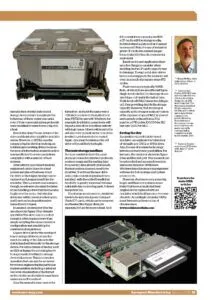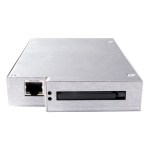Reproduced here with the kind permission of the Editor of Aerospace Manufacturing.
Article in Aerospace Manufacturing, January 2024 issue. View pdf of the article here
Solid-state-based emulators are increasingly replacing floppy drives and other yesteryear storage technologies. Brian McSloy explains how solid-state-based swap-in drives are keeping host system operational and delivering new features.
The aerospace and defence sectors are renowned for the length of service systems and platforms must provide. Not surprisingly there are computer-based systems such as flight simulators, radar systems and automatic test equipment (ATE) stations in service today that were built more than 40 years ago.
Many of these systems were designed to use removable media such as magnetic (floppy) disks, magneto-optical (MO) disks or magnetic tapes. For example, some airlines are currently using Airbus A320 aircraft that had their maiden flights back in the 1980s, when floppy disk was the primary means of data transfer.
These old-technology drives all have moving parts that, over the years, have worn. Their failure might be imminent, potentially resulting in considerable problems when the host system loses its ability to read or write data.
Unfortunately, new replacements are obsolete; superseded years ago by newer technologies such as SD card and USB. Even early generation hard disk drives (HDDs) are now obsolete.
However, it is not just that the original storage devices have become obsolete. Alternatives that use the same physical interfaces are not available either. For example, an extremely popular way of connecting computer peripherals in the 1980s (and through to the early 2000s) was the small computer system interface (SCSI, “scuzzy”). It was standardised in 1986 as the SCSI parallel interface (SPI) 8-bit wide, single-ended bus. The standard evolved through a number of iterations, doubling the number of data lines to 16 and incorporating differential signalling (allowing the transfer rate to significantly increase) before finally being superseded by the serial attached SCSI (SAS) interface.
Many data storage device types – including floppy, MO, tape and HDD – adopted SCSI. However, above, the word ‘standardised’ must be taken with a pinch of salt because OEMs did not always implement the full standard. For example, they often retained just the SCSI command protocol or the SCSI architectural model. Moreover, many SCSI drives were designed with a specific host in mind, and the latter would only interface with that exact model number (see figure 1).
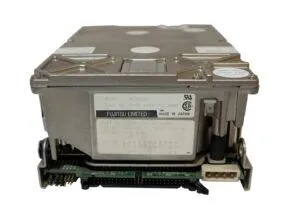
Figure 1 – Above, this Fujitsu SCSI HDD was manufactured in the 1990s to fit a 1980s design for an IBM host computer. The drive has a standard 50-pin connector for data and control, and a 4-pin Molex connector for power. However, the positions of the connectors are such that they will mate only with corresponding connectors in the host’s chassis.
The unavailability of a new or reconditioned drive need not mark the end of the hosts system’s life, though.
Emulation
A number of companies are specialising in the design and manufacture of solid-state-based storage devices that can replicate the behaviour of these yesteryear units, even if their communications protocols were modified to make them unique to a host.
How is this done? Some details of the drive and its interface might be available online. However, in Solid State Disks Ltd’s (SSDL’s) case the company had to develop techniques to interrogate working drives because the level of information available online was insufficient to create emulations compatible with a number of host systems.
Alternatively, specialised analysis equipment can be taken to a host system and placed between it and the drive so that signal timings can be captured and programmed into the emulator. This is a worst-case scenario though, as extreme care must be taken when handling a drive that has become fragile over the years – but which is still in use within a host, is relied upon and there’s no backup/alternative immediately to hand.
In essence, an emulator (like the one shown in Figure 2) for virtually any 1980s/90s drive can be created though it often requires more than simply adopting the same connector configuration and emulating the communication protocol.
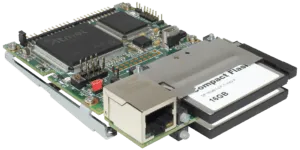
Figure 2 – Above, a solid-state-based SCSI drive with dual CF cards.
Legacy drives are for the most part based on logical blocks, where the exact encoding of the data onto the disk is handled internally by the storage device. For some classes of device, such as ESDI or floppy, the encoding has to be implemented within the storage device’s firmware. This is a complex operation that can only be achieved by reverse engineering the particular implementation, including a detailed low-level examination of the format written to the media (which sometimes varies across the surface).
Also, the emulator may need to be formatted – in much the same way a USB stick needs to be formatted to at least FAT32 for use with Windows, for example. In addition, some hosts will expect a new drive to be filled entirely with logic zeros. Others will require the old data to be present on the new drive, in which case it needs to be copied. Again, care must be taken as the old drive will most likely be fragile.
The New Storage Medium
Because emulators have the same physical connector, interface protocols, memory maps and formatting (and if necessary, data already preloaded), the host system does not need to be modified. It will treat the new drive as if a replacement original had been installed, with the added benefit that reliability is greatly improved because solid-state has no moving parts. It draws less power too.
The storage media used in emulators tends to be industrial grade Compact Flash (CF) cards, which can be removed and treated like floppy disks, for example, but are far more robust. And if the emulator is replacing an HDD, a CF card is still the storage media; hidden behind a plate so that it cannot be removed. Note, the use of industrial grade CF cards also assures longer-term availability than its commercial equivalent.
Based on the end application there are a few things to consider when deciding on the CF card’s capacity and technology. Though solid-state drives have no moving parts, the memory will wear as a result of program-erase (PE) cycles.
Flash memory is typically NAND flash, of which there are different types. Single-level cell (SLC) technology stores one bit per cell and is the fastest type. Multi-level cell (MLC) stores two bits per cell, thus providing double the storage capacity. However, that doubling of capacity and a cheaper memory comes at the expense of speed (MLC is slower) and a greatly reduced (circa 30x) number of PE cycles; 100,000 for SLC but only 3,000 for MLC.
Saving the Day
As mentioned, a solid-state-based emulator can replicate the behaviour of virtually any 1980s or 1990s drive. Also, the use of modern technology introduces many new possibilities. For instance, the emulator shown in Figure 2 has an Ethernet port. This means it can be networked and accessed remotely; and some emulator OEMs have Windows-based memory management software for hot-backups and system recovery etc.
However, obsolescence is a moving target, and there are systems in use today that have already had their original drives replaced with an emulator which itself has since become obsolete. Accordingly, emulator OEMs must themselves keep on top of obsolescence.
Media contact:
Amanda Warrilow, Communications Officer
Email: This email address is being protected from spambots. You need JavaScript enabled to view it.
Tel: +44 (0)1522 789000
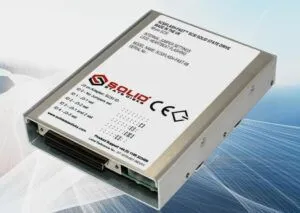
Southern Manufacturing & Electronics, Farnborough, United Kingdom – Solid State Disks Ltd. (SSDL), a leading manufacturer of solid-state-drives (SSDs) and a value-added reseller (VAR) of latest-technology Flash and DRAM solutions, has launched SCSIFlash-Fast™, a swap-in upgrade/replacement for electromechanical hard disk drives (HDDs) that use the SCSI interface.
Initially available with 68- and 80-pin connectors and write speeds of up to 80MB/s, SCSIFlash-Fast™ uses proven SCSI drive architecture and industrial CFast or M.2 SSD memory (with storage capacities ranging from 2GB to 1TB). The drive features configurable hardware, allowing the OEMs of (or those responsible for maintaining) legacy systems to replace or upgrade obsolete HDDs that were made in the 1980s, 1990s and early 2000s, and improve system reliability and security.
James Hilken, SSDL’s Sales & Marketing Director, says: “There are several computer-based systems in use within aerospace, defence, manufacturing, medical, telecommunications and other sectors that were designed decades ago and were fitted with then state-of-the-art SCSI hard disk drives. With their moving parts, these long-obsolete drives are increasingly failing. Our SCSIFlash-Fast drive is a highly reliable swap-in replacement for virtually any SCSI hard disk drive that’s more than 20 years old.”
SCSIFlash-Fast™ is configured to order and can replicate the exact behaviour of the SCSI HDD it replaces, meaning no modifications need to be made to the host system; which in many cases must not be modified (i.e. its functionality has been certified) or it is simply not cost-effective to do so. With SSDL’s SCSIFlash-Fast™, the SCSI version is set to that of the host system (SASI, SCSI-1, SCSI-2 or Ultra3) and the disk sector size is set to 256, 512, 768, 1024, 2048 or 4096. Other configurations can also be applied, including the preloading of data.
“We have made it possible to remove an old-tech SCSI drive and insert a SCSIFlash-Fast and the host system will not detect the difference,” adds Hilken. “Also, because ours is a solid-state drive it is far more reliable than the drive it replaces, is more secure, draws less power and is quieter. It can also be networked, thanks to an optional Ethernet port, which means it can be accessed remotely for backs ups and system reboots, for example.”
Other SCSIFlash-Fast™ features include its ability to automatically detect 16- or 8-bit data operation, as well as single-ended (SE) and low voltage different (LVD) signalling. Also, more than one SCSI address and logical unit number (LUN) can be supported by a single unit, and its microcode is field upgradable via USB.
SCSIFlash-Fast™ requires a 5VDC supply and will consume just 0.8W (plus whatever power the storage media draws, which will vary depending on memory type). The form factor is an industry-standard 3.5” disk drive (102 x 147 x 25mm (W x L x H)).
SCSIFlash-Fast™ is available immediately and detailed datasheets of the two launch drives can be viewed and downloaded from www.solidstatedisks.com/legacy-tapes-drives.
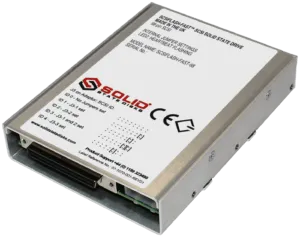
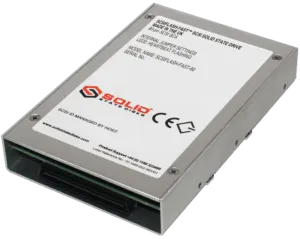
Available with 68- (left) and 80-pin (right) connectors, Solid State Disks Ltd.’s SCSIFlash-Fast™ drive can replicate the exact behaviour of virtually any SCSI hard disk drive, thus restoring the reliability of (and user confidence in) computer-based systems design decades ago, still relied on today and which must provide several more years of service.
Media contacts:
James Hilken, Sales Director, Solid State Disks
Tel: +44 (0) 1189 323499. Email: This email address is being protected from spambots. You need JavaScript enabled to view it.
Amanda Warrilow, Communications Officer
Email: This email address is being protected from spambots. You need JavaScript enabled to view it.
Tel: +44 (0)1522 789000
In a Q&A session, Solid State Disks’ Sales Director, James Hilken looks at the latest trends and demands surrounding the areas of memory and storage and what the sector needs to consider when designing and developing new systems.
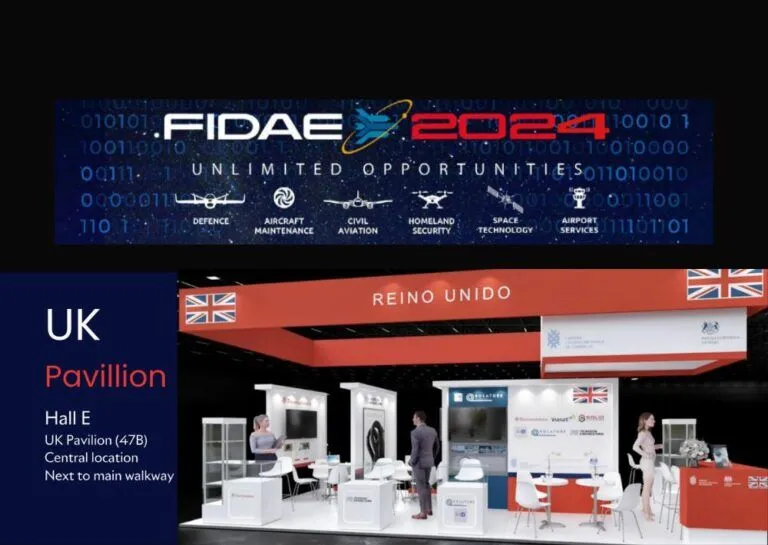
Reading, United Kingdom –Solid State Disks Ltd (SSDL) and Arraid LLC, advanced storage systems design, development and integration specialists, have been invited to exhibit on the UK Pavilion stand at the International Air and Space Fair (FIDAE), in Santiago, Chile, between 9th and 14th April.
FIDAE is Latin America’s oldest and most widely recognized aerospace, defence and security exhibition. This year’s event will be a multi-sectorial event covering the following areas: civil and commercial aviation, defence, airport equipment and services, homeland security, aircraft maintenance and space technology.
“We’re delighted to have been invited to exhibit at this year’s FIDAE,” comments James Hilken, SSDL’s and Arraid’s Sales & Marketing Director. “Within many of the sectors the event covers, equipment is used that was designed decades ago and uses legacy data storage devices, such as early generation SCSI, IDE (PATA) hard disk and tape drives and even ESDI, Shugart, and IDC floppy disk drives. With their moving parts, these drives are starting to fail.”
Hilken goes on to say that users are discovering to their dismay that spare drives purchased when the host system was new are failing as soon as they are powered up. “These drives are meant to be regular use otherwise you get problems. In the case of a still-boxed hard disk drive that’s been sat in stores for decades, the heads will have dropped and now be in contact with the disk’s surface. Spinning it strips the surface of its magnetic material.”
SSDL and Arraid will be using FIDAE to showcase and discuss its solid-state, swap-in replacements for electromechanical drives. Being solid-state they have no moving parts, are high reliability, draw less power and are quieter. Moreover, security is improved and more can be done with solid-state drives, such as networking and memory management.
SSDL and Arraid’s invitation to exhibit at FIDAE was received at about the same time the company officially launched its SCSIFlash-Fast™ drive at Southern Manufacturing & Electronics in Farnborough, United Kingdom; a product launch that received much interest from (and coverage in) the technical trade press.
SSDL and Arraid have also been invited to an evening reception before FIDAE starts that will be hosted by Louise de Sousa, His Majesty’s Ambassador (HMA) to Chile. In attendance will be other exhibitors, leading members of the armed forces and VIPS in the region.
About SSDL
Established in 1989, Solid State Disks Ltd (SSDL) is the industrial division of the Reactive Group of companies and specialises in the design, development and integration of advanced storage systems for mil/aero, commercial and industrial applications as well as the distribution of solid-state Flash memory and DRAM technologies.
Arraid is a privately held Arizona, USA corporation, and forms part of the Reactive Group of companies. Reactive Group has its headquarters in the United Kingdom but operates worldwide specialising in the design, development and integration of advanced storage systems for mil/aero, commercial and industrial applications as well as the distribution of solid state flash memory technologies.
SSDL announces Hot Standby - a mirrored dual CompactFlash-based replacement drive for legacy electro-mechanical storage peripherals
- Reduces risk and avoids the need for costly downtime
- Provides improved resilience and fault-tolerance
- Allows full disk image backups without demounting the drive
- Enables remote management of drive through a dedicated Ethernet port
Reading, UK– November 7, 2019. Solid State Disks Ltd (SSD), the advanced storage systems design, development and integration specialist, has launched HotBackup, a solid state ‘live host’ backup solution ideally suited for use in process and mission critical legacy computer systems in a broad range of applicationsin the telecommunications, semiconductor manufacturing, industrial process control, engineering and manufacturing, oil and gas, mil/aero and media post-production industries.

